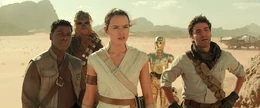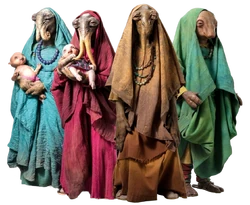- "Good place to lose someone, Pasaana. If you have someone to lose, that is."
- ―Unkar Plutt
Pasaana was a desert planet located in the Expansion Region's Ombakond sector that was the homeworld of the Aki-Aki species. Although the world was home to a great many dangers, the planet was famous for its joyous Festival of the Ancestors that attracted visitors from surrounding sectors.
Description[]
- "Pasaana is a desert world, but one full of surprises. And hazards. Sinking sands. Sarlaccs. Forbidden valleys. The Aki-Aki can be a bit too literal, you ask me."
- ―Unkar Plutt

The landscape of Pasaana
Pasaana was a terrestrial planet located in the Middian system,[2] a part of the Ombakond sector in the Expansion Region, positioned at the coordinates O-13[4] on the Standard Galactic Grid.[5] It orbited a star and was in turn circled by a single moon. Pasaana was 11,135 kilometers in diameter and its local year lasted 378 standard days. The planet had an arid climate[1] and supported a breathable atmosphere.[2]
The surface of the planet were long stretches of sun-bleached dunes and shrubland disrupted by the towering buttes of granite and sandstone that created shadowed valleys where water collected. Under the surface of Pasaana's deserts were a number of caves that connected to freshwater aquifers. However, a number of predators could be found in the caves; the threat they posed kept the Aki-Aki from overexploiting the water supply.[1]
The phedrugrass and termania-spore grew in the dustgrain farms, and they were a staple in Aki-Aki's diet.[1] Sarlaccs could also be found on Pasanna, becoming another one of the hazards unprepared travelers could fall prey to.[3] Pasaana was home to many insects, including gorpion, gouge-beetle, solif-spider, and thistlebuzzer. Other creatures included etobi, oki-poki, titan-erke, and vexis.[1]
History[]
Early history[]
Ancient Aki-Aki hunter-gatherers developed a language based on percussive stomp patterns, which later evolved into traditional dances of courting, aggression, and storytelling that continue to be performed in modern festivals. Aki-Aki history was not always peaceful; their species faced strife between scattered clans, though they eventually worked together to survive Pasaana's harsh climate.[1]
The hyperspace prospector Mari San Tekka, who Eye of the Nihil Marchion Ro used to locate unconventional Paths through hyperspace for the Nihil marauder group, discovered a route between Urber and Pasaana. San Tekka, believing Ro sold her Paths to the Galactic Republic, informed him of the route, which Ro stored in the central database of his flagship, Gaze Electric.[6]
New Republic Era[]
- "Luke and I were tailing an old Jedi hunter. Ochi of Bestoon. He was carrying a clue that could lead to a wayfinder. We followed his ship halfway across the galaxy here. When we got to his ship, it was abandoned.... No clue. No wayfinder."
- ―Lando Calrissian, on his and Luke's mission to Pasaana
In 21 ABY,[7] the Sith assassin Ochi of Bestoon was tricked into arriving on Pasaana during his quest to capture Darth Sidious' granddaughter Rey. After killing her parents, Dathan and Miramir, over the planet Jakku, the drunken Ochi spotted the Aki-Aki beads Miramir had hidden on her person and assumed Pasaana was Rey's hiding place. Instead, the girl was hidden on Jakku. Ochi died after entering the Forbidden Valley. Luke Skywalker traveled to Pasaana on a mission to locate Ochi. Lando Calrissian accompanied him[3] and helped track down the ship belonging to Ochi.[2]
Calrissian was taken with the humble nature of the native Aki-Aki people[1] and realized he had yet to search its quadrant for signs of his missing daughter, Kadara Calrissian. Telling Skywalker he would make Pasaana into his base of operations to search for both the lost girl and his daughter,[3] he took up residence on the planet as a hermit in the Forbidden Valley.[1]
First Order-Resistance War[]
- Poe: "What is this?"
- C-3PO: "The Aki-Aki Festival of the Ancestors! Oh! This celebration occurs only once every forty-two years."
- Finn: "Well, that's lucky."
- C-3PO: "Lucky indeed! This festival is known for both its colorful kites and its delectable sweets."
- ―C-3PO to Poe Dameron, Finn, Rey, and Chewbacca[2]

The Resistance followed Luke Skywalker's path to finding Exegol, which ended on the planet Pasaana.
In 35 ABY, after Sidious revealed himself and the Final Order was announced, Rey, Finn, Poe Dameron, Chewbacca, C-3PO, and BB-8 came to Pasaana on the trail of the planet Exegol. Their arrival coincided with the Festival of the Ancestors which occurred every forty-two years.[2] Despite the First Order having no established presence on Pasaana, as the world's meager resources and sparse population do not make it a worthwhile target, the influx of visitors for the festival warranted the dispatching of TIE fighters and stormtrooper patrols.[1]
While attempting to avoid First Order troops, they were found by Landonis Balthazar Calrissian, whom Organa had reached out to for help. Having accompanied Skywalker on his search for Exegol, Calrissian pointed the group in the direction of the Bestoon Legacy, an abandoned starship that belonged to the Sith assassin Ochi. As they traveled to the ship, they engaged First Order forces before being swallowed up by the Shifting Mires and ending up in the maze-like tunnels created by a vexis. The Resistance members would find the remains of Ochi of Bestoon, obtaining his dagger with the Sith inscriptions needed to locate the Emperor's wayfinder in the wreckage of the DS-2 Death Star II Mobile Battle Station on Kef Bir, and, although C-3PO was capable of translating it, he could not due to his programming restriction on speaking the language.[2]

Rey unintentionally destroyed the transport with Force lightning.
Rey agreed that they should extract the data from C-3PO and, anticipating the First Order had taken the Millennium Falcon, prepared to leave aboard Ochi's ship. Unbeknownst to the crew, the Knights of Ren had arrived on Pasaana to hunt them down. However, Rey sensed the arrival of Kylo Ren and left the group to confront him. Rey waited for Ren to attack in his TIE whisper, and subsequently destroyed it by slashing its wing with her lightsaber while leaping over to avoid being hit. After disabling Kylo's fighter, Rey discovered that Chewbacca and the dagger had been captured by the Knights of Ren Ap'lek and Kuruk and taken by troopers aboard an AAL-1971/9.1 Troop Transport. Rushing to help, Rey attempted to stop the transport carrying Chewbacca and the stolen Sith dagger using the Force. Kylo Ren tugged back, and the subsequent struggle resulted in Rey destroying the ship with a sudden burst of Force lightning, greatly shocking them both. Horrified by what she had done and thinking she had killed Chewbacca, Rey barely managed to escape in time from the oncoming TIE/fo space superiority fighters.[2]
Inhabitants[]

Pasaana's Aki-Aki were generally peaceful and hospitable, and welcomed offworlders to their planet.
Pasaana was the homeworld of the sentient Aki-Aki species[1] who spoke the Aki-Aki language.[2] The adult Aki-Aki were easily distinguished by the double prehensile trunks extending from their faces, while the young Aki-Aki instead had stubby snouts and eyes that were sunken into a round face of baby fat. They lost these rounded cheeks as they matured, leaving behind more pronounced ocular orbits. They only grew their bifurcated trunks upon reaching adulthood.[1]
They were generally peaceful and hospitable, and welcomed offworlders to their planet. The Aki-Aki maintained a pre-starflight level of civilization, but did adopt a number of advanced tools to aid in their life on Pasaana. Aki-Aki history was not always peaceful, however; their species faced strife between scattered clans, though they eventually worked together to survive Pasaana's harsh climate. Rather than concentrate in cities, the Aki-Aki kept to their disparate villages, but gathered together to trade at set times in their calendar.[1]
The Festival of the Ancestors was a legendary event, held every 42 years,[2] drawing people from across the galaxy. The centerpiece of the festival was an immense circle of bonfires that served as the symbolic portal to the ancestors, a gateway to the place where the Aki-Aki believed departed spirits lived on. The Forbidden Valley was packed with 500,000 Aki-Aki and 5,000 off-worlders during this time. Aki-Aki children were celebrated guests at the festival as they represented the future. The lack of amenities, such as hotels, spaceports, and restaurants, meant that only the desperate and determined came to visit. Local chiefs hired mercenaries for security during this time. They scanned the crowds, looking for other hired guns or fugitives. The chiefs did not want to become involved in galactic affairs, but they did want to keep the celebration peaceful. The xenolinguist Jaiyna Sibinth who regularly attended the Festival of the Ancestors noted recurring themes and symbols found in cultures native to other desert worlds, including Cona, Klatooine, Sriluur, and Tatooine.[1]
The Aki-Aki had a remarkable sense of rhythm, believed to be a by-product of their trunks and footpads having evolved to detect vibrations across the desert floor. Ancient Aki-Aki hunter-gatherers developed a language based on percussive stomp patterns, which later evolved into traditional dances of courting, aggression, and storytelling that continue to be performed in modern festivals. Aki-Aki were able to quickly fall into step with beats, and produce vast acts of seemingly spontaneous choreography. Their largest dance was known as Lobeha Mwadu.[1]
Music was central to many Aki-Aki traditions, and their oldest folklore was preserved in songs handed down over countless generations. Their double trunks and hardy lungs had prompted the development of a diverse array of wind instruments. The Aki-Aki also relished using their broad hands and feet to slap percussion instruments of many sizes, some improvised and others intricately designed. Other performers visited the festival to see Aki-Aki virtuosos in action and to spot burgeoning talent among the self-trained. Many music-lovers simply loved the heady mix of storied heritage blended with creative flair and innovation that ensured no two performances were ever the same.[1]
Economy[]
The main economic activity on Pasaana was dust farming. Even though the Aki-Aki mostly reject all post-starflight technologies, there was a rare exception. The desert winds carried dangerous seeds spores blown from across the world. Specialized electro-sifters could pluck these from the gusts and drag them into the collection hoppers. These also contain moisture vaporators, allowing a grid of them to form an underground dust farm. The phedrugrass and termania-spore made up a large part of the Aki-Aki diet. However, the arid conditions meant lots of land has to be used to yield crops. Many farmers made use of skimmers to cross their farms.[1]
Locations[]
Rather than concentrate in cities, the Aki-Aki kept to their disparate villages, but gathered together to trade at set times in their calendar. One of these was the Aki-Ktura farming community with a population of 3,000. The rocky valley known as the Forbidden Valley was the site of the Festival of the Ancestors. Other locations included the Ikledu Wastes, Jamtareen Mountains, and the Lurch Canyon.[1]
Behind the scenes[]
Pasaana appears in the 2019 saga film Star Wars: Episode IX The Rise of Skywalker.[2] The planet was filmed in the Wadi Rum desert in the nation of Jordan.[1]
Appearances[]
- The High Republic: Light of the Jedi (Mentioned only)
- The High Republic: Light of the Jedi audiobook (Mentioned only)
- The High Republic: A Test of Courage (Mentioned only)
- The High Republic: A Test of Courage audiobook (Mentioned only)
- Star Wars: Starfighter Missions
- Shadow of the Sith
- Shadow of the Sith audiobook
- Star Wars: Batuu Bounty Hunters (Mentioned only)
 Star Wars: Galaxy's Edge — Ronto Roasters (Mentioned only)
Star Wars: Galaxy's Edge — Ronto Roasters (Mentioned only)- Star Wars: Episode IX The Rise of Skywalker (First appearance)
 Star Wars Galaxy of Adventures — "Kylo Ren vs. Resistance Rebels"
Star Wars Galaxy of Adventures — "Kylo Ren vs. Resistance Rebels"- Star Wars: The Rise of Skywalker: Expanded Edition
- Star Wars: The Rise of Skywalker: Expanded Edition audiobook
- Star Wars: The Rise of Skywalker: A Junior Novel
- Star Wars: The Rise of Skywalker: A Junior Novel audiobook
Non-canon appearances[]
Sources[]
Notes and references[]
- ↑ 1.00 1.01 1.02 1.03 1.04 1.05 1.06 1.07 1.08 1.09 1.10 1.11 1.12 1.13 1.14 1.15 1.16 1.17 1.18 1.19 1.20 1.21 1.22 1.23 1.24 1.25 1.26 1.27 1.28 1.29 1.30 1.31 1.32 1.33 1.34 1.35 1.36 1.37 1.38 1.39 1.40 1.41 Star Wars: The Rise of Skywalker: The Visual Dictionary
- ↑ 2.00 2.01 2.02 2.03 2.04 2.05 2.06 2.07 2.08 2.09 2.10 2.11 2.12 2.13 2.14 2.15 2.16 Star Wars: Episode IX The Rise of Skywalker
- ↑ 3.0 3.1 3.2 3.3 3.4 3.5 3.6 Shadow of the Sith
- ↑ 4.0 4.1 Star Wars: Galaxy's Edge: Traveler's Guide to Batuu places Pasaana in what Star Wars: The Force Awakens Beginner Game identifies as grid square O-13 of the Standard Galactic Grid.
- ↑ Star Wars: Rogue One: Rebel Dossier
- ↑ The High Republic: Light of the Jedi
- ↑ Star Wars: Timelines

